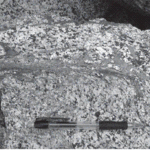Geology

Coastal erosion has more than doubled in Alaska – up to 45 feet per year – in a 5-year period between 2002 and 2007 along a 40-mile stretch of the Beaufort Sea, according to a U.S. Geological Survey(USGS) study that says average annual erosion rates along this part of the Beaufort Sea climbed from historical levels of about 20 feet per year between the mid-1950s and late-1970s, to 28 feet per year between the late-1970s and early 2000s, to a rate of 45 feet per year between 2002 and 2007.
USGS scientist and lead author Benjamin Jones cautioned that it is possible that the recent patterns…

To astrobiologists, hot springs hold a great deal of significance. Many of the most ancient organisms on Earth thrived in and around hydrothermal springs and their modern descendants still do.
If life forms have ever been present on Mars, hot spring deposits would be ideal locations to search for physical or chemical evidence of these organisms and data from the Mars Reconnaissance Orbiter (MRO) suggesting there might be evidence of ancient springs in the Vernal Crater would be a fine place to look, according to a report in Astrobiology.
Carlton C. Allen and Dorothy Z. Oehler, from the…

While in no way sexy, paleomagnetic dating stands the test of time for being useful. You probably remember a demo from science class where a sheet of paper is laid over a bar magnet, and iron filings are scattered lightly onto it. The filings line up with the fields generated by the magnet, in patterns that look rather like bottom-to-bottom fireworks bursts. Something similar occurs when rock is formed, whether by heat or by sedimentation.
Microscopic iron particles in the rock line up with the Earth’s magnetic fields as they are oriented at that time. But unlike the iron…

You mat have read recently about chemical fossils discovered in sedimentary rocks in Oman. Those fossil steroids, remnants of a type of sponge known as Demosponges, are between 635 and 750 million years old. They date back to around the time of the Marinoan glaciation, the last of the huge ice ages at the end of the Neoproterozoic era.
The research suggests that the shallow waters in some late Cryogenian ocean basins contained dissolved oxygen in concentrations sufficient to support simple multicellular animals at least 100 million years before the rapid diversification of bilaterians…

Rocks formed only under the extreme heat and friction during earthquakes, called pseudotachylytes, may be more abundant than previously reported, according to new research focused on eight faults found in the Sierra Nevada. The research appears in the February issue of the Bulletin of the Seismological Society of America.
Geologists have previously debated whether these rocks are rarely produced or not based on an apparent absence in the rock record, most likely brought about by the difficulty in identifying them. Only a small fraction of the energy released in an earthquake is consumed by…

It wasn't always the case that people believed in continental drift, German geologist and meteorologist Alfred Wegener's(1) theory that parts of the Earth's crust slowly drift atop a liquid core. He believed 200 million years ago there was once a gigantic supercontinent which he called Pangaea ("All-earth") which slowly moved apart.
Wegener’s theory of continental drift became commonly accepted when the driving forces for continental drift were discovered during the 50s and 60s: The enormous heat in the Earth’s core and Earth’s mantle generates the flow of rocks within the…

Did a catastrophic flood of biblical proportions occur, as stated in the story of Noah's Ark? If so, it may have been the shores of the Black Sea that were drowned 9,500 years ago, wiping out early Neolithic settlements around its perimeter.
Ten thousand years ago, at the end of the last glacial period, the Black Sea was a lake—cut off from the Sea of Marmara and beyond it the Mediterranean by the Bosphorus sill. Debate in geological and archaeological circles has focused on whether, as glaciers melted and global sea levels began to rise, the Bosphorus sill overflowed gradually…

The fossil of a lizard-like New Zealand reptile has been identified by a team of scientists from University College London, University of Adelaide, and the Museum of New Zealand Te Papa Tongarewa. The fossil, dating back 18 million years, has triggered fresh arguments over whether the continent was fully submerged some 25 million years ago.
The endangered New Zealand tuatara (Sphenodon) is a lizard-like reptile that is the only survivor of a group that was globally widespread at the time of the dinosaurs. The tuatara lives on 35 islands scattered around the coast of New Zealand,…

If you're a reader of geography or a student of eastern philosophy, you may have seen the name K'un Lun. It is the name of a mountain range in western China and borders the northern edge of Tibet (1) and is also a name for 'paradise' in Taoism. Whoever can climb to the top of K'un Lun gains access to the heavens, the ancients said.
There's a city there now and if you visit K'un Lun City and drink the yellow water in the lakes of its parks known as cinnabar (tan), they also say you will become immortal.(2)
That last part is scientifically undocumented.…

Scientists have achieved the first definitive detection of methane in the atmosphere of Mars, which would seem to indicate our reddish neighbor is biologically active. Or geologically active. Or both.
Wait, how can a bunch of smart people from NASA not know which?
It's because methane, four atoms of hydrogen bound to a carbon atom, is the main component of natural gas on Earth and is released by organisms as they (and we) digest nutrients but is also created in purely geological processes, like oxidation of iron.
"Right now, we do not have enough…